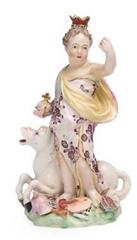salt
attributed to: Bristol porcelain factory (English, estab. 1770, closed 1782); manufacturer: William Cookworthy (English, b.1705, d.1780);
circa 1770-circa 1772
See full details
Object Detail
Description
Salt or Sweetmeat Stand, modelled with a complex design of dolphins, shells, seaweed and coral supporting scallop shell shaped dishes
In 1770 Cookworthy moved his works to Bristol, an area with a long history of ceramics production and an experienced workforce.
The design of this salt or sweetmeat stand is similar to A1395, and the same descriptors of production and period apply, except that William Cookworthy has succeeded in refining the porcelain body, which is evident by the whiter colour of the paste, when compared with the earlier Plymouth salt. Both this body and the earlier hard-paste porcelain body at Plymouth have the plasticity to accommodate the complex moulded design of dolphins, shells, seaweed and coral and the strength to support the large scallop shell dishes on the dolphin tripod.
In 1770 Cookworthy moved his works to Bristol, an area with a long history of ceramics production and an experienced workforce.
The design of this salt or sweetmeat stand is similar to A1395, and the same descriptors of production and period apply, except that William Cookworthy has succeeded in refining the porcelain body, which is evident by the whiter colour of the paste, when compared with the earlier Plymouth salt. Both this body and the earlier hard-paste porcelain body at Plymouth have the plasticity to accommodate the complex moulded design of dolphins, shells, seaweed and coral and the strength to support the large scallop shell dishes on the dolphin tripod.
Maker and role
attributed to: Bristol porcelain factory (English, estab. 1770, closed 1782)
manufacturer: William Cookworthy (English, b.1705, d.1780)
manufacturer: William Cookworthy (English, b.1705, d.1780)
Production place
Bristol, England
Production date
circa 1770-circa 1772
Media description
porcelain (hard-paste), salt glaze
Measurements
200 x 160 x 180 mm
Credit line
purchased with funds provided by the Nina Stanton 18th Century Porcelain Bequest, 2017
Project credit line
This digital record has been made available on TJC Collection Online through a significant donation from the OPENING DOORS fund, the generous support of The Friends of The Johnston Collection, and Digitisation Champion Christine Bell
Accession number
A1396
TJC reference number
1753


